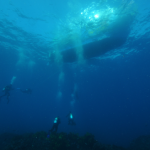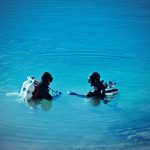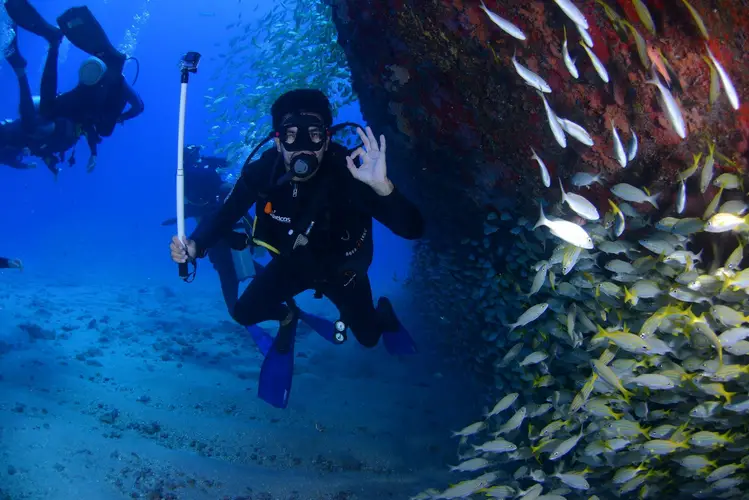
If you love the water, and especially if you love snorkelling, then you will probably also love scuba diving too. I still remember that feeling I got when I did my very first scuba dive. But as with all hobbies, you are probably looking into how expensive scuba diving is as a hobby.
Scuba diving is an expensive hobby and will cost on average $300 to get certified depending on where you learn. Buying your own equipment will cost at least $1,250 as a warm water wetsuit diver without your own dive tank and weights, and a two tank boat dive trip will cost between $60-$70.
The best way to do more diving is to book yourself on a scuba diving liveaboard. You can check the latest and best deals on liveaboards using the following window:
How expensive is scuba diving as a hobby - equipment options
| Low Cost | Medium Cost | High Cost | |
|---|---|---|---|
| 1. Snorkeler kit cost | £45/$65/€55 | £80/$115/€95 | £100/$140/€120 |
| 2. Warm water wetsuit scuba diver kit cost | £900/$1,250/€1,050 | £1,450/$2,050/€1,700 | £2,700/$3,750/€3,200 |
| 3. Colder water wetsuit scuba diver kit cost* | £950/$1,300/€1,100 | £1,500/$2,200/€1,800 | £2,800/$3,900/€3,300 |
| 4. Wetsuit scuba diver kit cost | £1,200/$1,600/€1,400 | £1,800/$2,600/€2,200 | £3,200/$4,500/€3,800 |
| 5. Drysuit scuba diver kit cost | £1,900/$2,700/€2,300 | £3,000/$4,200/€3,500 | £5,800/$8,000/€6,900 |
| 6. Complete scuba diver kit cost | £2,000/$2,800/€2,400 | £3,200/$4,400/€3,700 | £6,000/$8,500/€7,200 |
1. Snorkeler kit cost: Mask, snorkel, fins, wetsuit socks. But if you go for the cheaper option, this includes close-heel (Full foot) fins, so you won't need to buy wetsuit socks/boots, which cost around £20 ($30€/25).
2. Warm water wetsuit scuba diver kit cost: Mask, snorkel, fins, wetsuit socks, wetsuit, regulator package, BCD, dive computer, dive torch, SMB reel, SMB, DSMB, compass and bag.
3. Colder water wetsuit scuba diver kit cost*: Wetsuit diver kit: Mask, snorkel, fins, wetsuit socks, gloves, hood, wetsuit, regulator package, BCD, dive computer, dive torch, SMB reel, SMB, DSMB, compass and bag.
4. Wetsuit scuba diver kit cost: Mask, snorkel, fins, wetsuit socks, gloves, hood, wetsuit, regulator package, BCD, dive computer, weight belt, 4kg of weights, 12ltr dive tank, dive torch, SMB reel, SMB, DSMB, compass and bag.
5. Drysuit scuba diver kit cost: Mask, snorkel, fins, gloves, hood, regulator package, BCD, dive computer, drysuit, drysuit under suit, weight belt, 4kg of weights, 12ltr dive tank, dive torch, SMB reel, SMB, DSMB, compass and bag.
6. Complete scuba diving kit cost includes: Mask, snorkel, fins, wetsuit socks, gloves, hood, wetsuit, regulator package, BCD, dive computer, drysuit, drysuit under suit, weight belt, 4kg of weights, 12ltr dive tank, dive torch, SMB reel, SMB, DSMB, compass and bag.
* If the water gets too cold you will need to consider investing in a semi-drysuit or a drysuit - please take a read of this article: Wetsuit temperature guide.
The type of scuba equipment you buy will affect the total cost of your hobby
With regards to the type of kit you should get and what it will cost you, below are a few pointers using the main headings in the above table. But before I do, it’s important to understand the difference between the three cost ranges in the table, as follows:
- Low cost – This would be to choose to buy the cheaper ranges of products of scuba diving equipment. But this price level still includes a good quality Buoyancy Control Device (BCD) and a quality regulator package too.
- Medium cost – This is for the cost of buying your diving equipment in the mid range of brands and products. It’s not the best and most expensive, but then it’s also not the cheapest either.
- High cost – If you’re the type of person who likes the best of the best and to buy top brands, this is what it will cost you to get kitted up for your scuba diving hobby.
How to make your scuba diving hobby cheaper
Other thoughts to make your scuba diving hobby a bit cheaper includes looking on eBay to buy second-hand dive kit.
But please be careful with this, especially when it comes to buying your regulators, plus I’d also include your BCD too. Most important is your regulator, as this is your underwater life support system. You want to make sure this is both safe and of good quality, otherwise you’ll be putting yourself and your dive buddy at risk.
However, if you buy second hand kit, including your regulators, please make sure you have them checked and serviced before you use them on a dive.
This may also be obvious, but worthwhile saying in any event, look out for sales when you could save quite a lot of money on your scuba diving equipment.
You could also wait for the November Black Friday sales, and this may well help to make your scuba diving hobby even cheaper. But also consider visiting a scuba diving show, as often times you can get great deals on diving equipment at these events too.
Before you buy scuba diving equipment
Before you buy any scuba diving equipment you need to consider the following:
- How much diving you plan to do: If you plan on diving regularly, then it makes complete sense to buy your own diving equipment. Otherwise the cost of renting equipment each time you dive will make your scuba diving hobby very expensive.
- The type of diving you plan on doing: What scuba equipment you buy largely depends on the type of diving you plan to do. For example, if you live in a country where the waters are cold like the UK or in the northern states of America, then you should invest in a drysuit. But if on the other hand you only ever plan on diving in warm waters, then a wetsuit is all you’ll need (see below for an idea of water temperatures).
- Do you plan on being a travelling scuba diver? If you only ever plan to dive when you’re on holiday, either on a scuba diving safari on a liveaboard or on a resort, you need to consider light weight equipment and you won’t need dive tanks and weights in this case.
- Scuba equipment maintenance: Like any equipment, scuba diving equipment requires maintenance, which is especially true of your regulators. You should have your diving regulators serviced each year, as this is your life support system.

1. Snorkeler kit cost – $65-$140
I know this is about how expensive scuba diving is as a hobby, but it’s worth looking at what it will cost for snorkel equipment, as these are the basics for scuba diving too. Most scuba divers, myself included, will also enjoy snorkeling as a hobby too. If you go on a scuba diving holiday, it’s likely you’ll also go snorkeling.
When you go scuba diving, it’s far nicer to use your own mask, as you know it fits properly and doesn’t leak, plus it hasn’t been used by anyone else.
However, if you only get the basics, you’ll need to hire the rest of your scuba diving equipment, which can get quite expensive in the long run and can be as much as $90 per day for all the equipment. But it does get cheaper for multi-day use, and the cost of hire will depend on where you hire it from.
I do therefore recommend that if you’re serious about getting stuck into scuba diving as a hobby, that you buy your own equipment.
2. Warm water wetsuit scuba diver kit cost – $1,250-$3,750
This is when things get a bit more expensive with your scuba diving hobby, which is the point when you commit to buying more scuba gear. But always bear in mind that you don’t necessarily have to buy all this kit in one go. Whatever you buy will start to reduce the cost of hiring equipment each time you dive.
The warm water wetsuit scuba diver kit cost includes your snorkelling basics of a mask, snorkel and fins, but it also includes the following:
- Wetsuit socks, but you could save $20-30 if you buy the closed-heel (Full foot) fins off this amount. Closed-heel fins are perfectly good for warm water diving.
- Wetsuit, and the cost of this does depend on the brand you choose, whether it’s a full length wetsuit or a shorty wetsuit and on how thick the neoprene is on the wetsuit.
- Regulator package, which includes the cost of your main regulator, your octopus regulator and first stage that connects to a diving tank and the air contents consol. You can buy these things separately, but on the basis you are a beginner diver and you won’t have any of this kit to begin with, it makes sense to buy this as a package to make it cheaper. You can also get packages to include the BCD too, which would make the total cost even cheaper.
- Buoyancy Control Device or BCD, and if I were you I’d buy a lightweight BCD that’s ideal for travelling. These tend to be cheaper in any event. Plus, as noted above, and as you’re buying your complete dive kit, you can get packages to include the regulator set with your BCD.
- Dive computer, which is a piece of kit I recommend you buy early on when you take up scuba diving as a hobby. I started scuba diving when dive computers were not available, so I know what it’s like to dive without one. But I’d never go back to diving without a dive computer now, and if I forget to take it with me, and have to rely on someone else (which is rare), I miss it terribly. A dive computer makes for easier and safer diving.
- Other diving equipment includes a dive torch, which is essential in my mind, as I even take mine on day diving, as well as on night dives. This is so I can illuminate under crevices, inside wrecks and caverns. You might like to take a read of this article to help you decide on this point, which is why use a diving torch scuba diving (It’s not just for night diving). I also recommend you buy a Surface Marker Buoy reel, a surface marker buoy (SMB) and a delayed surface marker buoy (DSMB) too. The SMB is essential if you’re going to be doing any drift diving, and the DSMB is a good piece of safety diving kit to have on most dives (which is what I take with me). A compass is always good to have when you’re diving, especially on shore dives and finally, you’ll need a dive bag to put all your diving kit in too.
3. Colder water wetsuit scuba diver kit cost – $1,300-$3,900
The difference between the colder water wetsuit scuba diver kit cost vs warm water wetsuit scuba diver kit cost is that the warm water wetsuit scuba diver kit cost includes a hood and gloves for diving in slightly colder water. All the other details are the same, as in the above list.
But you may find that if the water is beginning to get cold enough to require a dive hood and gloves, you may like switch to a drysuit instead.
An alternative is to buy a semi-drysuit, which is a thicker neoprene suit that is designed for colder waters vs thinner wetsuits. For more information on these last two points is to read:
- What is the difference between a wetsuit and a drysuit?
- What is the difference between a drysuit and a semi dry suit?
- Wetsuit temperature guide scuba diving.
Reading each of these articles will help you decide what type of scuba diving to do when you get certified, and ultimately how much this hobby is going to cost.
4. Wetsuit scuba diver kit cost – $1,600-$4,500
The additional kit for this cost scenario includes the following, which is in addition to the colder water wetsuit scuba diver kit cost:
- Weight belt and weights, which are required if you want to be diving equipment as a self sufficient diver. I have included the cost for 4kg of weight, but if you require more or less than this amount, you’ll need to adjust the cost accordingly. The cost of weights works out at roughly $10 per kg. The cost of weights will be different if you have a integral weights in your BCD, which would also save the cost of a weight belt too, which would roughly save $17-49.
- 12 litre dive tank, which is something you’ll need buy if you want to dive by yourself with a dive buddy. There are times when two tanks make more sense, which is what I have. If you want your own dive tanks and do a two tank dive trip you will need to buy two of these. The cost per 12 litre dive tank is between $273-$490 depending on the brand you choose and the material of the dive tank.
5. Drysuit scuba diving kit cost – $2,700-$8,000
The drysuit kit cost assumes you don’t buy a wetsuit and wetsuit socks or boots, but instead you buy a drysuit ($1,100-$3,500) and a drysuit under-suit $70-$520. This is on the assumption you intend to cold water dive only.
Having said that, it’s more likely you’ll also buy a wetsuit so you can dive in warm waters too, which would bring this cost to the complete scuba diving kit cost, as below.
6. Complete scuba diving kit cost – $2,800-$8,500
The complete scuba diving kit cost means your scuba equipment includes everything you need, whether this is to dive locally near you in either a wetsuit or a drysuit, or if you want to take your dive gear away with you on a scuba diving holiday.
If you have never dived in a drysuit, you should read about what it’s like to dive in a drysuit first. Having a drysuit opens up where you can dive, which can even include cold water diving Antarctica, keeping warm diving the Galapagos Islands, or diving places like the Farne Islands in the UK.
Now to break these costs down into the individual scuba diving equipment.
Cost of scuba diving equipment
- Mask snorkel and fins as a package – $65-$140: Whatever type of diving you decide to do, you should buy the three of these, no matter what. In addition to this package, and if you buy open-heeled fins, you will need to also buy wetsuit socks or booties, which cost and extra $20-$55.
- Wetsuit – $85-$365: If you plan on diving in water temperatures no colder than 18-21°C (64-70°F), you only need to buy a wetsuit. Although towards the lower end of this scale you may need to get a thicker wetsuit or a semi-drysuit, which will be more expensive than a thinner wetsuit or a shorty that’s designed for warmer waters. It’s important when you buy a wetsuit (or a semi-drysuit) that it fits snugly to minimise water flushing.
- Neoprene diving hood – $30-$65: You will need a diving hood if you dive in colder waters, and this is a handy addition if you dive in a drysuit to keep your head warm.
- Neoprene diving gloves – $30-$85: You will need gloves if you dive in colder waters, and this is a handy addition (no pun intended) if you dive in a drysuit to keep your hands warm.
- Regulator package – $430-$840: Buying your own regulator set is one of the best investments you can make. Having your own regulators means you can get comfortable with how it breathes underwater. Plus you are the only one who has it in your mouth. A regulator package includes your main regulator, an octopus regulator, the first stage, and air contents console.
- Buoyancy control device (BCD) – 240-$520: Your buoyancy control device holds your dive tank in place and regulates your buoyancy too. This is another good thing to buy, as you get familiar with how it works. Be aware that BCDs can be heavy, so if you plan on flying with your BCD, make sure to go light with a travel-BCD.
- Dive computer – $225-$910: A dive computer monitors your depth, your total dive time, your ascent rate and logs your dives. A dive computer is something you should consider investing in as soon as possible, as it makes it much easier to monitor each dive.
- Drysuit – $1,100-$3,500: You will only need a drysuit if you intend to dive in waters colder than around 18-21°C (64-70°F), depending on how much you feel the cold. In addition to buying a drysuit, you will also need to buy a drysuit under-suit too, which cost between $70-$520 in addition to the cost of the drysuit. Unless you buy a neoprene drysuit that is.
- Weight belt and weights – $50-$120: If you plan to dive near you and independently of a diving organisation, you will need a weight belt and weights. This price includes for 4kg of weights, but if you need more than this, add roughly another $10 per extra kg.
- Dive tank – $275-$500: This is the price range for a 12 litre tank, and if you plan to dive near you and independently of a diving organisation, you will need to buy a dive tank. Dive tanks need to be serviced regularly for them to be filled with air, which is a further ongoing cost to your hobby if you have your own tanks.
- Dive torch – $50-$350: A dive torch is a must-have piece of diving kit to own and not very expensive. I take my dive torch on every dive, as I nearly always use it to illuminate something on most dives.
- Surface market buoy (SMB) and reel – $45-$85: If you plan on diving drift dives, you will need an SMB and a reel too. But then a great piece of safety kit to have is a delayed surface marker buoy (DSMB) or surface sausage, which can usually be connected to the same reel you use for your SMB. The addition of a DSMB is $35-$125.
- Compass – $15-$115: Having a compass is useful to have, especially if you plan on diving shore dives. You should plan to add this to the console of the regulator package, and buy it at the same time.
- Dive bag – $55-$240: You will need to buy a dive bag to put your kit in to take on a dive boat or to a shore dive.
How much does it cost to scuba dive regularly?
The cost of scuba diving regularly ranges from $5 for an air fill for shore dives to $60-$70 for two tank boat dive trip. The cost of a two tank dive trip is dependent on where the dive is and the distance from the shore. The cost for a two tank dive trip far off shore could be as high as $100.
How much does it cost to get started scuba diving?
To get started scuba diving there’s the cost of getting certified, which on average is $300. You need at least some basic equipment to get started, including a mask, snorkel and fins, which cost between $60-$140, but then you’ll need to hire the rest of your equipment at about $90 per day.
Your equipment hire will be more expensive if you hire a drysuit if the diving is in colder waters, but the more equipment you can buy, the less the equipment hire will be of course.
On going training and advanced diver certification increases the cost of your hobby
The cost to get certified as a scuba diver is on average $300, but this only gets you to the first stage of certification, which for PADI is the open water diving certification. You might like to read this article if you want to find out more on the common depths for a beginner diver, and what depth is considered a deep dive.
As you progress with your scuba diving hobby, you will probably want to add to your diver certification so you can dive deeper and on different types of dive, like a night dive or a drift dive. This will add more costs to your hobby, but it’s worth it.
The cost of scuba diving as a hobby will also be affected by which diving organisation you choose. With that in mind, you may like to read about the differences between PADI, SSI, NAUI and BSAC. Which organisation you choose will not only affect the cost of getting certified to start with, but it will also affect the further training you do too.
But it’s not just about the cost of the training, it’s also about the convenience of where each training centre is located. PADI are the easiest organisation to train with, as they have PADI dive centres across the world. This will make it easy to find somewhere to train.
But keep in mind that the costs associated with taking the additional training can soon mount up, which will begin to make this hobby even more expensive.
Other costs of the scuba diving hobby
Dive liveaboard costs
What I recommend you include in your scuba diving hobby is scuba diving liveaboards. Liveaboard diving is the best way to get more dives under your belt and increase your diving experience. You should take a read of the best liveaboard diving for beginners, which includes the top 10 destinations.
Table of liveaboard dive boats
This list of liveaboards is in descending customer rating order, followed by Scuba Diving Luxury Rating (SDE Lux Rating, see below), so the liveaboards with the highest customer rating and the best SDE lux rating will be at the top of the list. If you want to change the list order, use the “Sort by” dropdown below.
| Discover Liveaboard | Customer Rating | SDE Lux Rating % | Flexible Booking | Dive Courses | Dietary Requirements | Nitrox | Country | |
|---|---|---|---|---|---|---|---|---|
 |
Review: KLM Mikumba 2; Book: KLM Mikumba 2 | 9.6 | 73% | YES | YES | YES | NO | Indonesia |
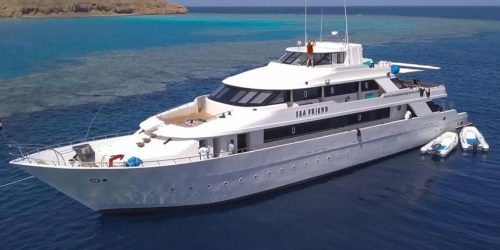 |
Review: MY Sea Friend; Book: MY Sea Friend | 9.6 | 71% | YES | YES | YES | YES | Egypt |
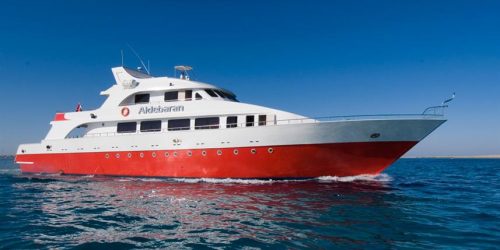 |
Review: MY Aldebaran; Book: MY Aldebaran | 9.6 | 67% | YES | YES | YES | YES | Egypt |
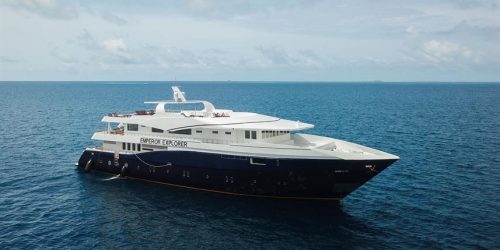 |
Review: MV Emperor Explorer; Book: MV Emperor Explorer | 9.6 | 63% | YES | YES | YES | YES | Maldives |
 |
Review: KLM Sea Safari VII; Book: KLM Sea Safari VII | 9.6 | 62% | YES | NO | YES | YES | Indonesia |
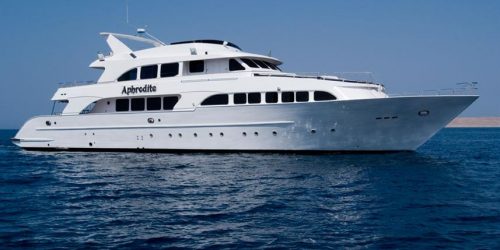 |
Review: MY Aphrodite; Book: MY Aphrodite | 9.5 | 88% | YES | YES | YES | YES | Egypt |
 |
Review: MSY Seahorse Liveaboard; Book: MSY Seahorse Liveaboard | 9.5 | 88% | YES | YES | YES | YES | Indonesia |
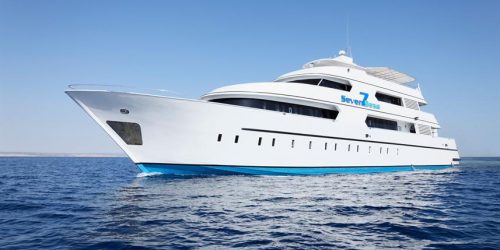 |
Review: MY Seven Seas; Book: MY Seven Seas | 9.5 | 87% | YES | YES | YES | YES | Egypt |
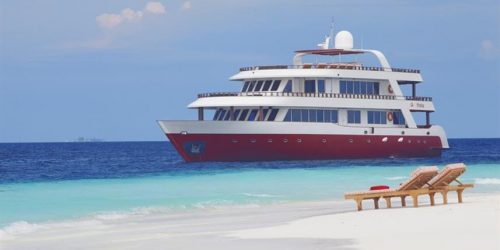 |
Review: MV Theia; Book: MV Theia | 9.5 | 85% | YES | YES | YES | YES | Maldives |
 |
Review: Coralia; Book: Coralia | 9.5 | 85% | YES | YES | YES | YES | Indonesia |
The Scuba Diving Earth Luxury Rating (SDE Lux Rating) is explained on each liveaboard review when you click the “Discover Liveaboard” link, and is my own Liveaboard Luxury Rating I’ve assigned to all liveaboards. Choosing between liveaboards is helped by customer scores, and if you get stuck choosing between two or three liveaboards, where each one has a high customer score out of 10, you can use the SDE Luxury Rating to help narrow down your choice.
Think about it like using Booking.com when searching for the best hotel. Booking.com also use a customer score where each customer rates hotels out of 10. This is similar to the liveaboard customer rating, which is also rated out of 10. But let’s say you only like to stay in hotels rated 8 and above on Booking.com, but you also want the hotel to have WIFI or parking, or to have a swimming pool etc. The features each hotel has is usually secondary to the score out of 10.
Nitrox diving adds cost to diving hobby
If you plan on diving with nitrox, there’s the additional cost of the training, together with the ongoing cost of nitrox fills too. Nitrox air fills do add further cost to scuba diving, but there are a number of benefits to using nitrox air.
Mixed gas diving adds cost to diving hobby
If you plan on becoming a technical diver and diving deeper than normal recreational dive depths, or diving beyond decompression dive time limits, you will need to consider mixed gas diving.
This adds a further layer of costs to your scuba diving hobby, as you will need additional equipment and the gas mixed can be expensive. You may also decide to take up rebreather diving, which will add yet another layer of cost, not least with the cost of a rebreather, which can cost upwards of $8,000-$8,500,
Is scuba diving a good hobby?
If you love the water then you’ll love scuba diving as a hobby, and if you love snorkeling, scuba diving is the next best step to take. Scuba diving is more expensive as a hobby than snorkeling, but when you experience your first dive and can breath underwater you’ll never forget it.
Finally, if you want to laugh, and keep something in mind for when you take up this great hobby, please take a look at this article 5 Scuba Diving Entry Techniques (Tips For Entering The Water Safely).
Whilst this article will come in handy later on as you progress with your diver training, I wasn’t necessarily suggesting you take a look for that reason. Instead it is for you to watch the video at the end of the article. Each time I watch it, it always makes me laugh every time. It’s one of those blooper type videos or “it’ll be alright on the night” type of things. It’s about how not to enter the water.
But then if you are fascinated with sharks, and if you want to know what fish can eat sharks, you should really watch this video too. I won’t spoil it for you, but you should watch the video on this article right to the end, it’s amazing. But you may also be amazed at the second video showing a moray eel fighting with a whitetip reef shark.
Is it worth it to get scuba certified?
If you want to take up scuba diving as a hobby, then it is worth it to get certified. Scuba diving is classified as a dangerous sport and needs to be respected as such, which is why you need to understand the dangers so they can be avoided when you dive.
You should read this article on is it dangerous to scuba dive. This article includes 10 of the biggest dangers that scuba divers face, and only one of these relates to dangerous sea creatures. The rest cover dangers that can be avoided if you have the correct diver training and experience.
Before you leave, you may like to take a watch of both videos on this article about what fish eat sharks. You may be as surprised as I was when you see what happens! What fish can eat sharks?
It is moments like these that are captured in these two videos that make the expense of a scuba diving hobby worth it.
I hope you enjoyed this article about how expensive is scuba diving as a hobby
I’d love to hear from you. Tell us about your adventures of diving and snorkeling, in the comments below. Please also share your photos. Either from your underwater cameras or videos from your waterproof go-pro’s!
If this article hasn’t answered all of your questions. If you have more questions either about snorkeling or scuba diving (or specifically about how expensive is scuba diving as a hobby), please comment below with your questions.
There will also be many more articles about scuba and scuba diving safety tips (and on snorkeling too) for you to read and learn about this fabulous sport.
Have fun and be safe!

